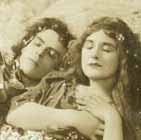Key Word Search
Multi-Field Search
Browse
Repertory Report
Performers Report
Contacts
Met Opera Website
World Premiere, New Production, In the presence of the composer
Königskinder
Metropolitan Opera House, Wed, December 28, 1910
Debut : Edna Walter, Lotte Engel
Königskinder (1)
Engelbert Humperdinck | Elsa Berntsein
- Goosegirl
- Geraldine Farrar
- King's Son
- Hermann Jadlowker
- Witch
- Louise Homer
- Fiddler
- Otto Goritz
- Woodcutter
- Adamo Didur
- Broommaker
- Albert Reiss
- Broommaker's Child
- Edna Walter [Debut]
- Broommaker's Child
- Lotte Engel [Debut]
- Innkeeper
- Antonio Pini-Corsi
- Innkeeper's Daughter
- Florence Wickham
- Stable Maid
- Marie Mattfeld
- Gatekeeper
- Herbert Witherspoon
- Gatekeeper
- William Hinshaw
- Councillor
- Marcel Reiner
- Tailor
- Julius Bayer
- Conductor
- Alfred Hertz
- Director
- Anton Schertel
- Set Designer
- Burghart & Co.
- Set Designer
- James Fox
- Costume Designer
- Louise Musaeus
- Costume Designer
- Blaschke & Cie
- Composer
- Engelbert Humperdinck
Königskinder received sixteen performances this season.
Whenever he sang the brief role of a Gatekeeper, Witherspoon used the pseudonym Ernst Maran.
Review 1:
Review of Henry Krehbiel in the New York Tribune
A German opera can generally stand severer criticism than one in another language, because there is a more strict application of principles in Germany when it comes to writing a lyric drama than in any other country, so in the present instance there is no need to conceal the fact that there are outbreaks against the German language which are none the less flagrant and censurable because they are, to some extent, concealed under the thin veneer of the allegory and symbolism which every reader must have recognized as running through the play. This is, in a manner, Wagnerian, as so much of the music is Wagnerian-especially that of the second act, which because it calls up scenes from the "Meistersinger" must also necessarily call up music from the same comedy. But there is little cause here to quarrel with Professor Humperdinck. He has applied the poetical principle of Wagner to the fairy tale which is so closely related to the myth, and he has with equal consistency applied Wagner's constructive methods musically and dramatically. It is to his great honor that, of all of Wagner's successors, he has been the only one to do so successfully. . . Though the composer hews to a theoretical line he does it freely, naturally, easily and always with the principles of musical beauty as well as that of dramatic truthfulness and propriety in view. His people's voices float on a symphonic stream, but the voices of the instruments, while they sing in the endless melody, use the idiom which nature gave them. There is an admirable characterization in the orchestral music, but it is music for all that; it never descends to mere noise, designed to keep up an irritation of the nerves.
With what exquisite charm an artist like Miss Farrar might invest a character like that of the Goose Girl her admirers could easily fancy before they entered the theatre, but it is doubtful if anyone's imagination quite reached the figure which she bodied forth. It was a vision of tender loveliness which she presented, and as perfect in conception as in execution.
Note: "At the close of the opera Miss Farrar caused "much amusement" by appearing before the curtain with a live goose under her arm. The composer, who had viewed the performance from the auditorium, was summoned to the stage and was presented with a silver laurel wreath by Manager Gatti-Casazza on behalf of the company."
Alfred Hertz, Engelbert Humperdinck, and Giulio Gatti-Casazza around the time of the world premiere of Humperdinck's Königskinder. Photography by Herman Mishkin.
Geraldine Farrar and Hermann Jadlowker in Königskinder. Photograph by White Studio.
Search by season: 1910-11
Search by title: Königskinder,
Met careers
- Alfred Hertz [Conductor]
- Geraldine Farrar [Goosegirl]
- Hermann Jadlowker [King's Son]
- Louise Homer [Witch]
- Otto Goritz [Fiddler]
- Adamo Didur [Woodcutter]
- Albert Reiss [Broommaker]
- Edna Walter [Broommaker's Child]
- Lotte Engel [Broommaker's Child]
- Antonio Pini-Corsi [Innkeeper]
- Florence Wickham [Innkeeper's Daughter]
- Marie Mattfeld [Stable Maid]
- Herbert Witherspoon [Gatekeeper]
- William Hinshaw [Gatekeeper]
- Marcel Reiner [Councillor]
- Julius Bayer [Tailor]
- Anton Schertel [Director]
- Burghart & Co. [Set Designer]
- James Fox [Set Designer]
- Louise Musaeus [Costume Designer]
- Blaschke & Cie [Costume Designer]
- Engelbert Humperdinck [Composer]

